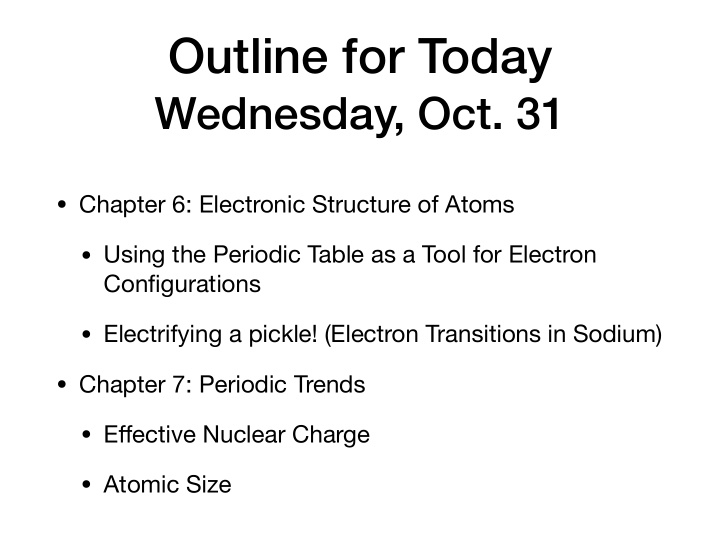



Outline for Today Wednesday, Oct. 31 • Chapter 6: Electronic Structure of Atoms • Using the Periodic Table as a Tool for Electron Configurations • Electrifying a pickle! (Electron Transitions in Sodium) • Chapter 7: Periodic Trends • E ff ective Nuclear Charge • Atomic Size
Example: Electron Configurations of atoms and ions 1. What is the electron configuration for Nitrogen?
Using the Periodic Table as a Tool For Electron Configurations N 1s 2 2s 2 2p 3
Example: Se Se
Se Se: [Ar] 4s 2 3d 10 4p 4
Pb 4f 14 5d 10 Pb: [Xe] 6s 2 6p 2
Challenge Questions! • What is the electron configuration of Ag + ? • How many unpaired electrons does Ag + have? • Can an electron in Ag + be in a 5p orbital?
Challenge Questions! • What is the electron configuration of Ag + ? • How many unpaired electrons does Ag + have? • Can an electron in Ag + be in a 5p orbital? • Can an electron in a ground state Ag + be in a 5p orbital? No. • Can an electron in an excited state Ag + be in a 5p orbital? Yes!
Time to Cook the Pickle! 3p Voltage Excites the Electron 3s Electron Configuration of Sodium (Na)
Time to Cook the Pickle! ! d 3p e t t i m E n o t o h P As the electron relaxes to the ground state, a photon comes out. 3s Electron Configuration of Sodium (Na)
Angular and Radial Nodes of the 3p Orbital Angular Node 𝝨 Radial Node
Effective Nuclear Charge
Why do orbitals with the same principal quantum number, n, increase with angular momentum quantum number, l ? Nucleus (+)
Example Problems: Effective Nuclear Charge • If the core electrons were totally e ff ective at screening the valence electrons and the valence electrons provided no screening for each other, what would be the e ff ective nuclear charge acting on the 5s valence electrons in Strontium ?
Atomic Radius
Trends in Atomic Radius Cs Rb K Na Radius (pm) Li Xe Kr Ar Ne He Atomic Number
Cation and Anion Sizes Li Be B O F Cations are SMALLER than their neutral atoms. Anions are LARGER than their neutral atoms.
Trends in Size in a Group (Column) O Li S Na Se K Te Rb
Example Problems: Atomic Radius • Arrange the following atoms in order of increasing size (smallest to largest) • Ge, K, Kr, Cr • Pb, C, Sn, Si • Li, F , Na, H • S 2- ,Ca 2+ , Ar, K +
Recommend
More recommend